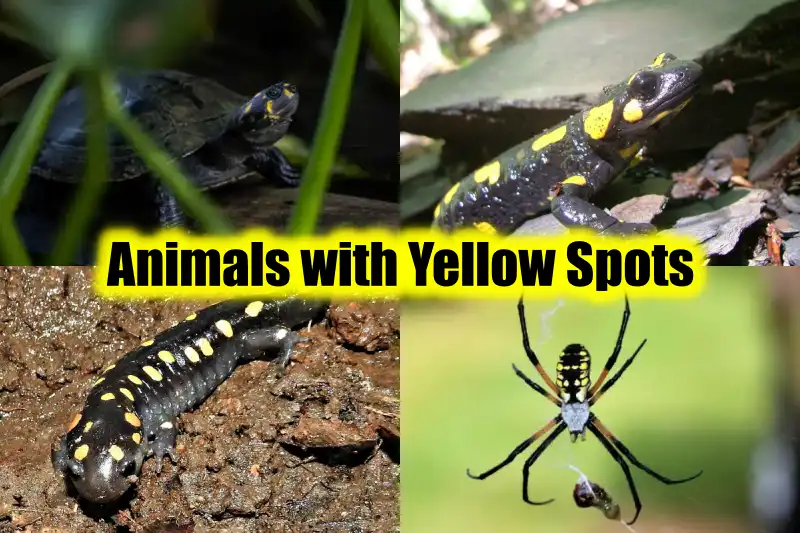Nature is the reservoir of many varieties of animals, ranging from different sizes to different colors. Most of the time, such colorful organisms are associated with the fact that they can secrete toxic compounds. Hence, studying them will help us to identify them in our environment. Here we will discuss about 15 animals that have yellow spots on their bodies.
15 Animals with Yellow Spots
1) Yellow-Spotted Amazon River Turtle

- Scientific Name: Podocnemis unifilis
- Size: Ranges from 15 to 27 inches.
- Habitat: Native to the Amazon River basin and river systems of Venezuela, Brazil, etc.
- Diet: They are omnivorous, meaning they feed on small animals and plants.
- Colorful feature: They have distinct yellow markings on their carapace, face, and limbs.
The turtles favor rivers with calm waters and usually have a lifespan of 20 years.
2) Yellow Spotted Tropical Night Lizard
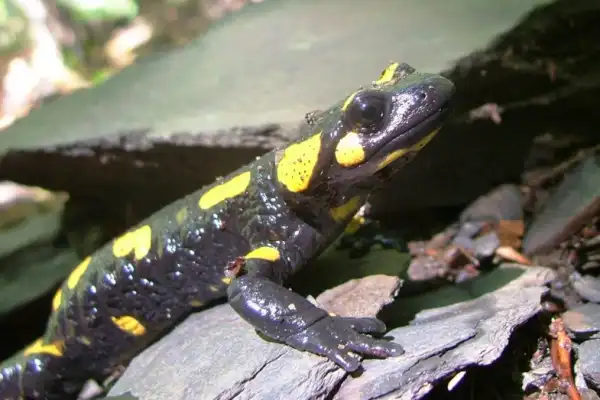
- Scientific Name: Lepidophyma flavimaculatum.
- Size: Grows up to 4 inches in length.
- Habitat: Found in the forest environments of Central America, Mexico.
- Diet: They primarily feed upon various forms of insects such as ants, and crickets.
- Colorful feature: Their body has yellow spots over a dark to greyish body.
As the name suggests, these lizards are nocturnal. They prefer to remain in small areas of the environment, known as microhabitats, and like to remain close to their homes.
3) Yellow-Spotted Monitor

- Scientific Name: Varanus panoptes.
- Size: 35 to 60 inches in length.
- Habitat: Found in woodlands, coastal region of Western Australia, Queensland.
- Diet: They are carnivorous and eat fish, rodents, crabs, etc.
- Colorful feature: Yellow spots on the back and tail with dark mosaic pattern.
These lizards are intelligent and have an intense personality. They are also skilled predators. They are also great diggers. The members of the species show a unique characteristic, where they stand up on their hindlegs and the long tail acts as a body support
4) Magnificent Tree Frog
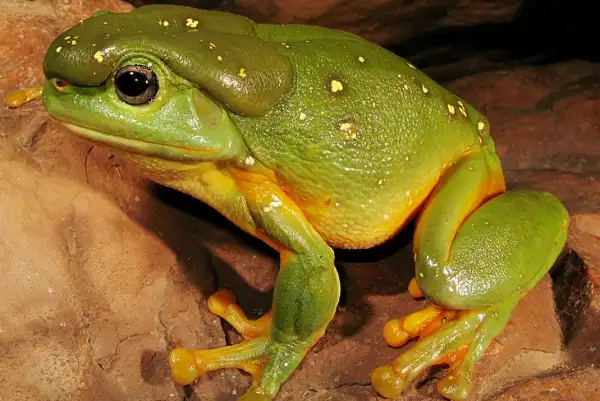
- Scientific Name: Litoria splendida.
- Size: Between 4.1 to 4.2 inches.
- Habitat: They can be found in areas of low rainfall, caves, or crevices.
- Diet: They are mostly insectivorous and feed on various insects such as spiders, ants, etc.
- Colorful Feature: Bright green body with spots of yellow color.
These frogs have a special sac-like structure on top of their heads which secretes poison. This is a defense mechanism that protects them from potential predators. The male members secrete a special pheromone in the water (known as Spendipherin) to attract female frogs during the breeding season.
5) Yellow Spotted Salamander
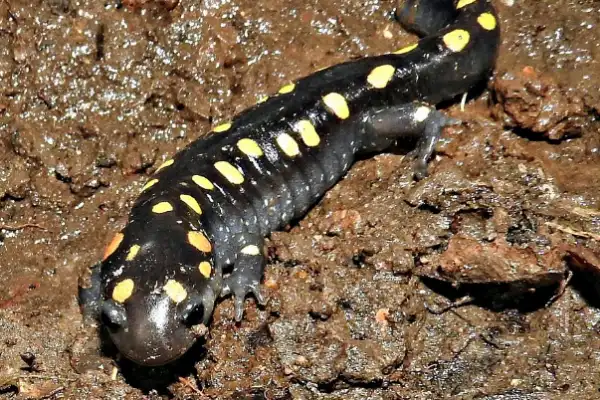
- Scientific Name: Ambystoma maculatum
- Size: They can grow up to 6 to 10 inches.
- Habitat: Usually found in deciduous or coniferous forests, wetlands, and swamps.
- Diet: Feeds on multiple types of invertebrates such as centipedes, snails, earthworms, etc.
- Colorful Feature: The body is dark with large yellow spots spread from head to tail.
Members of this species are aggressive predators in nature. They release a white-colored sticky toxin when they feel threatened by any predators. The adult salamanders have a special sensing ability due to which even if they are long meters away, they return to the specific pond where they hatched first.
6) Yellow Spotted Stink Bug
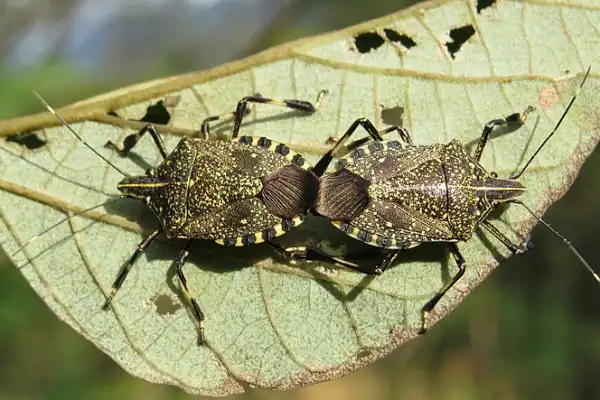
- Scientific Name: Erthesina full
- Size: Between 16 to18 mm
- Habitat: They are native to parts of Asia, Japan, and China. Resides in natural crevices, and gardens.
- Diet: Fluids from different fruits and leaves.
- Colorful Feature: Black body with yellow bands on legs and yellow spots on their back. A yellow line passes from the head to the front body.
These pear-shaped insects are generally not harmful to humans, but they release an unpleasant and odorous liquid which can cause stomach problems, vomiting, and mouth irritation. They are also known as hitchhiker pests because they can invade different places by arriving along with containers, bags, etc
7) Yellow Spotted Rabbit Snail
- Scientific Name: Tylomelania towutica
- Size: They can grow up to 4 inches
- Habitat: Found in freshwater mountain lakes of Indonesian islands in Southeast Asia
- Diet: Eats a wide variety of foods such as dried flakes, decaying plant matter, algae wafers, etc
- Colorful Feature: Overall body color is black, with patches of yellow spots all over. Their shell is dark brown.
Even though these creatures appear larger, they are very peaceful in nature. Their face and long, drooping antennae resemble that of a typical “rabbit”, hence the name. Their skin is rubbery, and they possess long snouts.
8) Yellow Spotted Grasshopper

- Scientific Name: Aularches miliaris
- Size: Ranges between 1.5 to 2.7 inches.
- Habitat: Lives in forests, crop fields, and grasslands throughout Europe and Asia.
- Diet: Herbivores, meaning they eat plant materials.
- Colorful Feature: Dark green head and thorax, with yellow band on the lateral sides. The legs are dark blue. Dark abdomen with red stripes. Yellow spots over green forewings.
Aularches grasshoppers are known to be pests in agricultural areas, destroying crops when they appear in large numbers. When they are disturbed, they make a rasping noise and release a toxic substance to ward off predators. They can also jump great heights with their strong legs.
9) Yellow Spotted Barbet
- Scientific Name: Buccanodon duchaillui
- Size: 16 to 17 cm
- Habitat: Found in dense vegetation and rainforest regions of Africa.
- Diet: Feeds mainly on fruits, seeds, and some small invertebrates.
- Colorful Feature: Dark blue head with a red patch on the forehead. Black wings with yellow spots and yellow feathers in the breast.
These beautiful-looking birds are very social and love to live in a group. They are popularly known for their sweet melodic songs and these birds act as indicators of forest health.
10) Yellow Garden Spider
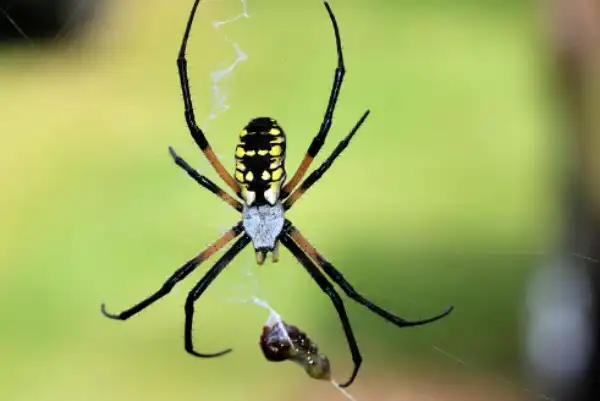
- Scientific Name: Argiope aurantia
- Size: Ranges between 0.25 to 1 inches
- Habitat: Usually resides in areas adjacent to Sunny fields and tall vegetation. They are found in Canada, Mexico, and Central America.
- Diet: Feeds on Various Small insects.
- Colorful Feature: The females have black abdomen with patches of yellow color. Legs are dark in the tip and reddish-brown in the base region. Males are not very colorful.
These spider species are also known as “writing spiders” because they make zig-zag patterns on their webs. The name “Argiope” means “silver face” because the spider’s head has a distinct silver coloration.
11) Yellow Spotted Diving Beetle
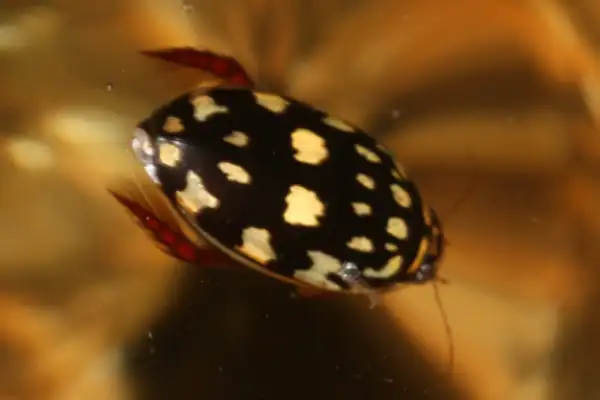
- Scientific Name: Thermonectus marmoratus
- Size: They are very small, ranging between 0.4 to 0.6 inches.
- Habitat: Found in slow-moving water streams, and pine forests of Mexico, Southwest California, and Western Texas.
- Diet: Carnivorous. They feed on small invertebrates and mosquito larvae.
- Colorful Feature: Black wing cover with many small yellow spots. The head is yellow with a M-shaped marking.
These beetles have strong legs and paddle-like appendages which makes them an efficient diver and swimmer, hence they have the title of “diving” beetles. Their eyes are well adapted for vision both above and below the water.
12) Yellow Spotted Scorpion Fish
- Scientific Name: Sebastapistes cyanostigma
- Size: Ranges between 4 to 6 inches.
- Habitat: Can be found in great depths underwater and in reef crests. Generally distributed in parts of Southern Japan, South Africa, etc.
- Diet: They are carnivorous. Feeds on small fishes such as Mollies.
- Colorful Feature: Overall body color is red, with tiny yellow spots on the body.
Their dorsal and pectoral fins are venomous, which they use for their defense. These fishes are well-known aquarium fishes in the market.
13) Yellow Spotted Mint Moth
- Scientific Name: Pyrausta aurata
- Size: Ranges between 0.7 to 0.8 inches.
- Habitat: Generally found in gardens woodlands, and marshlands. Geographically found in Europe, parts of North Asia, China, and Japan.
- Diet: They feed on plants.
- Colorful Feature: The wings are reddish-brown or dark brown, with round and transverse golden-yellow markings.
Members of this moth species are mostly day-flying. The caterpillars of this moth mainly feed on plant leaves of the mint family, hence the name “Mint” moth.
14) Yellow Spotted Fungus Beetle
- Scientific Name: Eumorphus quadriguttatus
- Size: Between 0.4 to 0.5 inches.
- Habitat: Found in nearby areas where different fungus and mushroom species grow. Distributed in different areas of India, Sri Lanka, and the Andaman Islands.
- Diet: Feeds on decaying vegetation and fungus. Sometimes they also favor eating small insects.
- Colorful Feature: The overall body is black, with four large yellow spots on the back.
These beetles are also called “handsome” fungus beetles due to their striking and bright appearance. Some species have the elytra (hardened front wings) extended around the body, which gives them a “saucer” shape.
15) Yellow Spotted Black Cicada
- Scientific Name: Gaeana maculata
- Size: Up to 1.2 inches.
- Habitat: Usually found in tree trunks and dense vegetation of forests of China.
- Diet: They are herbivorous and mainly feed on plant leaves.
- Colorful Feature: Overall body color is black. The forewing and hindwings have yellow spots on them, and there is a shade of light-orange color in the forewing tips.
These cicadas live for a few months only. When they die, they can be seen as clinging to a branch and remain lifeless. After some time, molds start to grow along their body, and their eyes become yellow.
Conclusion
Apart from these 15 animals, there are other animals as well as insects in nature. Their gorgeous designs are proof of Mother Nature’s artistic capabilities.
References-
MS herps.com, Reptiles magazine, A-Z animals, Landcare research, National Wildlife Federation The animal facts, Wildlife Trusts, NatureLovesyou, Pictureinsect.com
Hi everyone. I am Sagnik. Biology has always fascinated me since my school days and that interest motivated me to pursue a Bachelor’s degree in Zoology and a Master’s degree in Biotechnology. I learned a lot of new interesting facts and information regarding the biological world we are part of. After obtaining my degree, I started working as a biology teacher through which I am able to teach students the various concepts that I have learned. Apart from my love for this subject, my passion lies in music, and I teach guitar as well. Photography, Reading comics, Drawing, and video editing are some of my other hobbies. I welcome you to a journey with me, where I will share my knowledge and excitement for the living world through my writings with you all.
